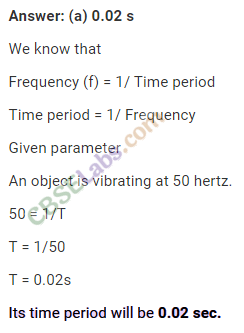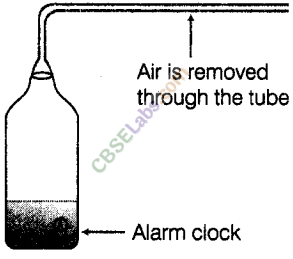NCERT Exemplar Class 8 Science Chapter 13 Sound are part of NCERT Exemplar Class 8 Science. Here we have given NCERT Exemplar Class 8 Science Chapter 13 Sound.
NCERT Exemplar Class 8 Science Chapter 13 Sound
Multiple Choice Questions (MCQs)
Question 1
A list of mediums is given below
(i) Wood (ii) Water
(iii) Air (iv) Vacuum
In which of these mediums can sound travel?
(a) (i) and (ii) (b) (i), (ii) and (iii)
(c) (iii) and (iv) (d) (ii), (iii) and (iv)
Answer.
(b) Sound requires any medium to travel but in vacuum there is no medium, so sound cannot travel through them.
Question 2
The loudness of sound depends on
(a) its amplitude (b) its time period
(c) its frequency (d) its speed
Answer.
(a) Sound will be loud when its amplitude is large and sound will be soft when its amplitude is small hence, loudness of sound depends upon its amplitude.
Question 3
Which of the following statements are correct?
(i) Sound is produced by vibrations.
(ii)Sound requires a medium for propagation.
(iii)Light and sound both require a medium for propagation.
(iv)Sound travels slower than light.
(a) (i) and (ii) (b) (i), (ii) and (iii)
(c) (ii), (iii) and (iv) (d) (i), (ii) and (iv)
Answer.
(d) Because light can travel in vacuum also but it is only sound which requires medium to travel.
Question 4
An object is vibrating at 50 Hz. What is its time period?
(a) 0.02 s (b) 2 s
(c) 0.2 s (d) 20 s

Question 5
order to reduce the loudness of a sound, we have to
(a) decrease its frequency of vibration of the sound
(b) increase its frequency of vibration of the sound
(c) decrease its amplitude of vibration of the sound
(d) increase its amplitude of vibration of the sound
Answer.
(c)Since, loudness depends upon amplitude, so it can be increased by increasing amplitude and it can be decreased by decreasing amplitude.
Question 6
Loudness of sound is measured in units of
(a) decibel (dB) (b) hertz (Hz)
(c) metre (m) (d) metre/second(m/s)
Answer.
(a) Unit of loudness of sound is decibel (dB). ,,
Question 7
The loudness of sound is determined by its
(a) amplitude of vibration
(b) ratio of amplitude and frequency of vibration •(c) frequency of vibration
(d) product of amplitude and frequency of vibration
Answer.
(a) Loudness of sound is determined by the amplitude of its vibrations.
Question 8
1 Hz is equal to
(a) 1 vibration per minute (b) 10 vibrations per minute
(c) 60 vibrations per minute (d) 600 vibrations per minute
Answer.
(c) 1 Hz = 1 vibration per second = 60 vibrations per minute
Question 9 Pitch of sound is determined by its
(a) frequency (b) speed
(c) amplitude (d) loudness
Answer.
(a) Pitch or shrillness is determined by the frequency of sound.
Question 10
Ultrasound has frequency of vibration
(a) between 20 and 20000 Hz
(b) below 20 Hz
(c) above 20000 Hz
(d) between 500 and 10000 Hz
Answer.
(c) Ultrasound has frequency of vibration above 20000 Hz.
Question 11
Lightning can be seen at the moment when it occurs. Paheli observes lightning in her area. She hears the sound 5 s after she observed lightning. How far is she from the place where lightning occurs?
(speed of sound = 330 m/s).

Question 12
Does any part of our body vibrate when we speak? Name the part.
Answer.
Yes, while speaking the part which vibrates is called vocal cords. It is below the throat and creates vibrations while speaking.
Question 13
Boojho saw a cracker burst at night at a distance from his house. He heard the sound of the cracker a little later after seeing the cracker burst. Give reason for the delay in hearing the sound.
Answer.
The light travels faster than sound. So, the light from the cracker reaches faster than that of sound of the cracker.
Speed of light in air = 3 x 108 m/s
Speed of sound in air = 330 m/s
Question14
When we hear a sound, does any part of our body vibrate? Name the part.
Answer.
Yes, It is the eardrum which vibrates and sends vibrations to the inner ear, when we hear any sound.
Question 15
Name two musical instruments which produce sound by vibrating strings.
Answer.
Guitar and sitar are the two musical instruments which produce the sound by vibrating strings.
Question 16
A simple pendulum makes 10 oscillations in 20 s. What is the time period and frequency of its oscillations?
Answer.
Given, number of oscillations = 10
Time taken = 20 s
As, we know that the number of oscillations per second is frequency.

Question 17
We have learnt that vibration is necessary for producing sound. Explain why the sound produced by every vibrating body cannot be heard by us.
Answer.
Since, range of frequency for every vibrating body is different. But we can hear the vibrations which lies between the range of frequencies from 20 Hz to 20000 Hz, so sound of every vibrating body cannot be heard by us.
Question18
Suppose a stick is struck against a frying pan in vacuum. Will the frying > pan vibrate? Will we be able to hear the sound? Explain.
Answer.
Yes, the frying pan will vibrate.
Since, it is being hit by the stick but vibrations need a medium to travel and there is no
medium in vacuum, so we’cannot hear the vibrations produced.
Question19
Two astronauts are floating close to each other in space. Can they talk to
each other without using any special device? Give reasons.
Answer.
No, they cannot talk to each other without using any special device because there is no medium in space and sound needs medium to travel.
Question20
List three sources of noise pollution in your locality.
Answer.
Sources of noise pollution gre .
(i) Horns of vehicles
(ii)Loudspeakers of temples
(iii)Generators running without silencers
Question 21
We have a stringed musical instrument. The string is plucked in the middle first with a force of greater magnitude and then with a force of smaller magnitude. In which case would the instrument produce a louder
sound?
Answer.
It will create more loud sound in case of string stretched with a greater force because amplitude is greater in this case and loudness depends on the amplitude. Greater will be the loudness, greater will be the amplitude.
Question 22
How is sound produced and how is it transmitted and heard by us?
Answer.
Sound is produced when any object starts vibrating by any means.
These vibrations travel from the source all around the environment through the particles of the environment, thus, it reaches to its destination, i.e. our ear.
Now, it enters our ear and travels down a canal at the end of which a thin membrane is stretched tightly known as eardrum. The eardrum sends vibrations to inner part of the ear and finally reaches to the brain and we hear the sounds.
Question 23
An alarm bell is kept inside a vessel as shown in figure. A person standing close to it can distinctly hear the sound of alarm. Now, if the air inside the vessel is removed completely, how will the loudness of alarm get affected for the same person?

Answer.
Initially, the person is able to hear the sound coming from air and water distinctly. But after sometime, when the air is completely removed from the bottle, the sound will pass through the water and not reached to man.
So, the man will not hear the sound which was coming through the air initially.
Question 24
The town hall building is situated close to Boojho’s house. There is a clock on the top of the townhall building which rings the bell every hour. Boojho has noticed that the sound of the clock appears to be much clearer at night. Explain.
Answer.
We know that speed, pitch, loudness all are initiated with a vibration. During the day, there is a number of vibrations around us. So, the sound coming from the clock gets disturbed and amplitude of vibrations becomes small.
But during the night, there are not such multiple vibrations in the environment. So, sound is more clear. Further,-“the dew factor at night increases the speed of sound as moisture level increases.
Long Answer Type Question
Question 25
Suggest three measures to limit noise pollution in your locality.
Answer.
The following measures to limit noise pollution in our locality is given as:
(i) The industries which produce noise should be setup away from the residential areas.
(ii)The television and the music systems should be run at the low volumes.
(iii)The aircraft engines, transport vehicles, industrial machines and home appliances ’ must be installed with siltncing devices.
NCERT Exemplar Class 8 Science Solutions
- Chapter 1 Crop Production and Management
- Chapter 2 Microorganisms: Friend and Foe
- Chapter 3 Synthetic Fibres and Plastics
- Chapter 4 Materials : Metals and Non-Metals
- Chapter 5 Coal and Petroleum
- Chapter 6 Combustion and Flame
- Chapter 7 Conservation of Plants and Animals
- Chapter 8 Cell Structure and Functions
- Chapter 9 Reproduction in Animals
- Chapter 10 Reaching the Age of Adolescence
- Chapter 11 Force and Pressure
- Chapter 12 Friction
- Chapter 13 Sound
- Chapter 14 Chemical Effects of Electric Current
- Chapter 15 Some Natural Phenomena
- Chapter 16 Light
- Chapter 17 Stars and the Solar System
- Chapter 18 Pollution of Air and Water
NCERT Exemplar SolutionsNCERT Exemplar MathsNCERT Exemplar Science
We hope the NCERT Exemplar Class 8 Science Chapter 13 Sound help you. If you have any query regarding NCERT Exemplar Class 8 Science Chapter 13 Sound, drop a comment below and we will get back to you at the earliest.